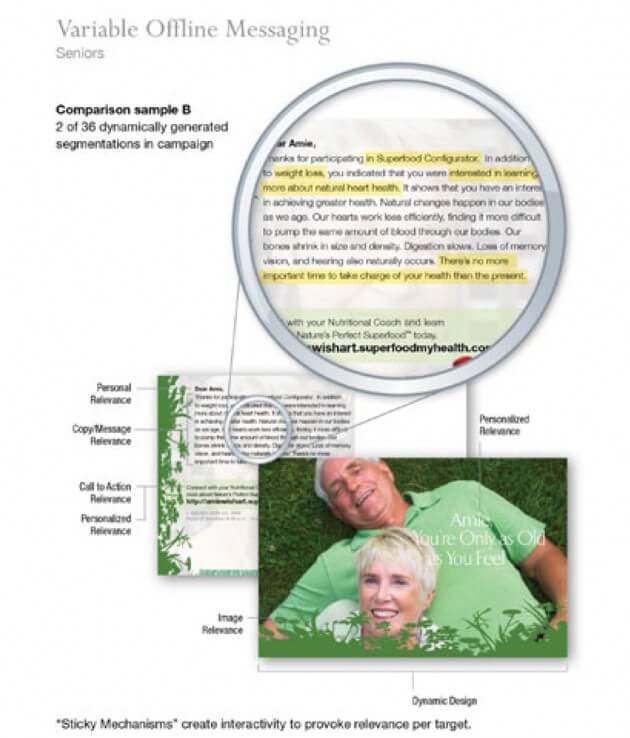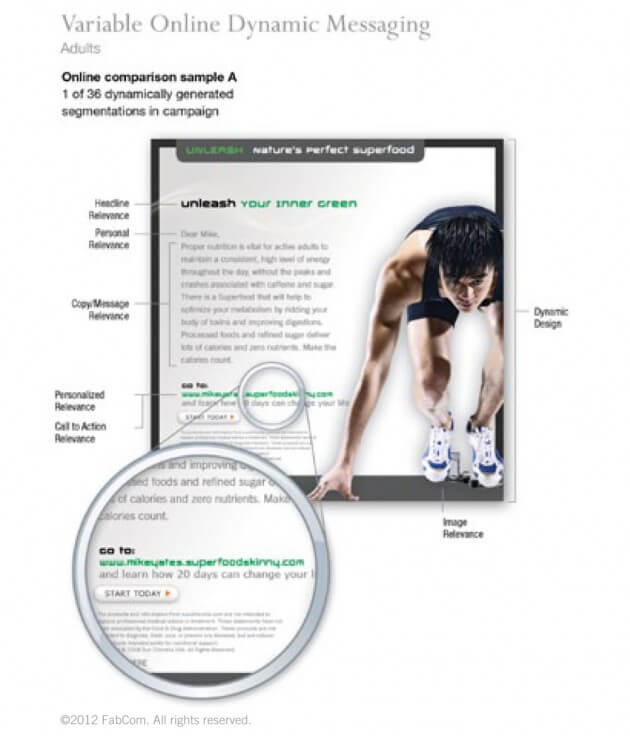
Marketing White Paper
Neuromarketology In Action – A Holistic Strategy
A Neuromarketing Campaign
Marketers have been talking about neuroscience and neuromarketing quite a bit the past few years. Yet, launching a neuromarketing campaign is still intimidating for most marketers. It needn’t be. Provided you have a team of neuromarketing experts in place, and the technology infrastructure to handle it (or you’re working with a partner agency that has the expertise and technology), it is relatively straightforward to launch, monitor and maintain even the most complex neuromarketing campaigns.
Real-Life Case Study
We recently worked with a nutritional supplement product derived from freshwater single-celled green algae. This green algae is organically loaded with naturally-occurring vitamins and antioxidants including: vitamin C, pro-vitamin A (beta-carotene), chlorophyll, lutein, thiamine (B1), riboflavin (B2), pyridoxine (B6), niacin and several more. When the client came to us, they were limiting their marketing reach to seniors aged 70-plus. Seniors made up the segment where they had the most success. But a product with this many powerful ingredients had to offer a wide range of benefits that could be relevant to many segments. Before we started a single creative initiative, we conducted secondary research through the FDA to find out what claims we could legally make for the product based on its amazing overall nutritional value. Not surprisingly, we were able to identify an extensive list of categories for which the supplement company could legitimately claim benefits according to the FDA, based on its documented nutritional values, including:
- Anti-Aging
- Wellness
- Digestion Health
- Detoxification
- Weight Loss
- Heart Health
- Eye Health
- Joint Health
- Energy & Fitness
- Brain Health
- Stress and Mood
- Sexual Health
Shattering Old Marketing Strategies
The traditional marketing methodology required the client to forgo most of these attributes and the subaudiences they could serve in order to reach the group most likely to purchase the highest volume. Many times they also fell into the common trap of trying to communicate all of these attributes on each and every message. Instead of staying with this traditional approach, we developed a strategy that mapped all of these various benefit areas to the audiences for which they were most relevant. For instance, Heart Health for seniors, Anti-Aging for Baby Boomers, and Energy and Fitness for twenty- and thirty-somethings.
We then developed a network of microsites, each one designed to promote a particular set of benefits to one audience segment.
These microsites/entry portals provided conditional and age-group relevance to engage each segment further. Rather than sending prospects to the one primary website that sacrificed the many brand attributes, and thus wider target audiences for the few messages believed supportable for the single target audience as an alternative, we first directed prospective consumers to microsites designed to achieve ultrahigh relevance per condition within demographic and behavioral groupings. This strategy assured a positive response to the prospective customer’s magic question and a solution to the online shopper’s three-second rule: “Is this right for me? Is this what I want, need or have been looking for?” Targeted and keyword-rich site names were developed, such as 65plusheartcondition.com for seniors and superfooddietcondition.com for younger adults, were selected for their relevance.
Engaging Customers In Conversation
For our dynamic marketing strategy, we needed to know our prospects on a one to one basis. To achieve this, we had to create interactivity that would stimulate the consumer dialogue with the brand. We developed and equipped each site and advertising initiative with “sticky tools” that were engaging and customer-centric. The sticky tools were customer-interactive experiences laced within all the communication channels that traded information that the consumer was motivated to provide, based on what they received in exchange: a nutritional recipe, a pH test kit, finding a naturopathic doctor in their area, etc. We developed 15 in all to reach each of the segments we’d identified.
(Remember, previously, this client was primarily engaging with one segment. The strategy broadened their reach to effectively contact consumers in 14 additional market segments.)
The sticky mechanisms enabled us to gather indepth information from prospective consumers, far beyond simply capturing their contact information. For example, we developed a “Nutritional Configurator,” which provided users with a snapshot of their unique nutritional requirements and personal recommendations for nutritional supplements, as needed. To use it, participants needed to input information about themselves such as their age, gender, level of nutritional supplementation, dietary information and health concerns. All together, this provided us with an extensive personalized profile for that prospective consumer. This information grouping, input by the prospects themselves, became the foundation for ongoing dialogue marketing, both online and offline.
Offline and Online Strategies
In addition, this entire targeting and retention strategy was integrated offline through a newly developed “Nutritional Coach” program rolled out with the contact center. Here’s where the if/then programming kicks in. If you’re a fifty-something male whose major concern is digestion and your level of supplementation is moderate and you eat one-to-two servings of fiber daily and you exercise three times a week, then you, the prospect, will receive messaging, imagery and calls to actions that speak directly to your needs and personal perspective. Now, that’s high relevance.

Each element of every communication is customized to demonstrate the product or service attributes that map to the individual’s particular potential interest in the brand.

Variable information is determined by the customer’s past or real-time online and offline interactions with the brand, partners and competitors.
Automated Methodology
The marketing tactics, including unique copy, imagery, offer and other variables, were automatically assembled from a pre-populated resource pool to map dynamically to product attributes and the consumer’s specific health concerns. All secondary funnels from the marketing campaign routed a customer to a PURL (personalized URL) that was anchored by the previously mentioned microsites that were mapped directly to the facet of the product that matched that consumer’s reason to purchase.
If we have a senior who is concerned about eye health and heart disease, then we send them a piece of direct mail at home that guides them to a dynamicallypopulated microsite that offers them the perfect solution with images of seniors and content about the combination of heart and eye health concerns.
Conversely, if another female senior was sent direct mail at home that spoke to her specific concerns of brain health and energy then she would be directed to a site featuring feminine imagery and the appropriate messaging that relates to her concerns and the productspecific ability to meet those specific concerns.
If we had Baby Boomers with digestion, energy, and fitness concerns, then we sent them an HTML and PURL link to a site automatically populated with content that was specific and visceral to these topics—all with our client’s product offered as the solution, of course.
Perfect Timing
To raise this highly relevant communication to the status of hyper-relevance, we added acute timing as well. We used advanced trigger marketing strategies and automated technologies to determine when and how each individual was touched. In this way, we achieved ultrahigh relevance, delivering the right message in the right way at the right time. That’s making an impact.
What’s really mind-blowing isn’t just that we touch this fifty-something male with the chronic upset stomach on a true one to one marketing basis, it’s that we replicate this process across the client’s entire customer base, into multiple new segments of consumers and over multiple segmentations of audience demographics and health needs, thereby expanding our customer’s reach of its supplement product from 70-plus only, to appealing to the entire demographic spectrum. This new methodology can do this efficiently and affordably—in real time with consistency in implementation and repeatability from month-to-month and campaign-to-campaign.
Assembly Required
What does it take to successfully execute such a strategy? Admittedly, it takes a lot of experience and knowledge and just the right technology. You need to gather team leaders with extensive, real-world experience in the various layers of this methodology, from dynamic database marketing to integrated crossplatform technology. You need people at every level of your operation who excel at their part in the process.
From writers and creative directors to programmers and brand strategists, the entire team has to understand their role in the implementation process and step up to deliver highly relevant and granular excellence. The bar for marketing professionals is much higher than one to many generic messaging, but so are the returns.
In addition, there is a significant technology investment required. If the old, legacy systems could do this, they would—but they cannot. It takes technology investment dollars and years of experience to get it right the first time. Fortunately, my agency is doing this today and there are a few more leaders emerging across the landscape now. But, beware, everyone is saying: “Of course we can do it.” The reality is that it takes eight different kinds of programmers, seasoned corporate and marketing strategists, creative directors, art directors and everyone on the same page; and we mean the next page, not the previous page.
You have to think of and create campaigns differently for this opportunity. If we create our new campaigns the same way we do traditional campaigns, they will work the same as traditional campaigns. In that case, why bother?
For enterprise level organizations, assembling this level of expertise may make excellent strategic and financial sense. For smaller organizations, it may be highly impractical. Better to purchase the marketing services when you need them. For larger organizations, as with anything new and emerging, it sometimes can be next to impossible to reshape from scratch and rethink your entire workflow without the support of others who are accomplished in this area and have already configured practices to sidestep the biggest pitfalls of implementation.
Here’s an easy analogy: Building a bike factory to build bikes would not be in most people’s best interest. Instead, buying the bike from others who already have the factory usually makes more sense. We have deployed these fully integrated cross-channel, dynamic, one to one marketing campaigns for less than $25,000 for some of our smaller customers. We also have other initiatives in the multi millions that have run for more than two years as of this writing. But, by understanding the opportunity now available, marketers can begin to deploy this methodology, whether through in-house resources or by partnering with carefully selected strategic partners.
As a result of our investments to date, and other marketing pioneers that are leading the way, smaller companies and brands can now harness the muscle and momentum of the Google Generation to grow and prosper, rather than be overwhelmed by it. You can break through the inherent barriers of one to many marketing and incrementally increase your marketing ROI by multiplying your brand’s reach to include the plethora of one to one marketing pools, rather than simply deploying the old 2% strategy and hoping for the best. With this new methodology, media fragmentation and the new emerging channels are no longer a threat to your strategy; they are now invaluable allies you can leverage to deliver improved results more affordably and effectively. That’s the power of Neuromarketology™.
In order to fully utilize the power of Neuromarketology™, we must first understand which of the foundational elements of marketing still apply as we plunge into the rapidly changing future of marketing and our ability to leverage the emerging technology. The principles of branding and positioning continue to anchor successful, efficient marketing.